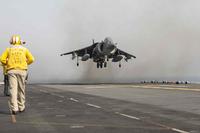"The US navy wants to protect its warships... by firing massive underwater shock waves" at incoming torpedoes," New Scientist says.
The ships would be equipped with arrays of 360 transducers each 1 metre square - effectively big flat-panel loudspeakers - running along either side of the hull below the waterline. When the ship's sonar detects an incoming torpedo, the transducers simultaneously fire an acoustic shock wave of such intensity that the torpedo either detonates early or is disabled by the pulse's crushing force, according to the Defence Advanced Research Projects Agency (DARPA), which is funding the project.
But these are no ordinary loudspeakers: instead of having a membranous diaphragm that can vibrate in response to a range of audio frequencies, each of the devices has a ram-like cylindrical metal armature at its centre. This is projected outwards by electromagnets at very high speed, producing a shock wave. The array can be fired as many times as needed.
When the six rows of 60 transducers on each side of the ship fire at once, the cumulative action should generate a "destructive pressure pulse capable of disabling an enemy's torpedo", according to DARPA.
(Big ups: AR)








